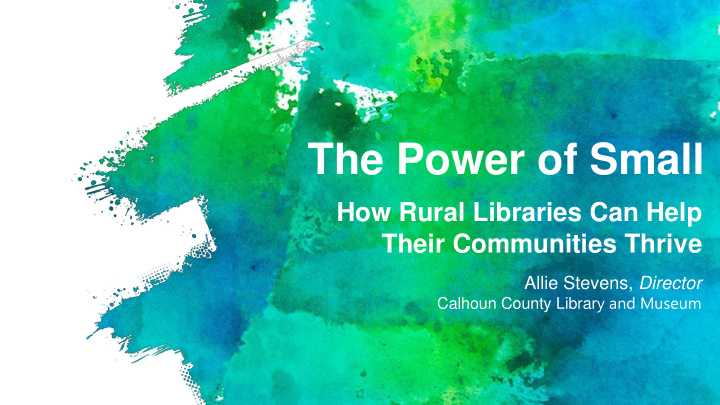



The Power of Small How Rural Libraries Can Help Their Communities Thrive Allie Stevens, Director Calhoun County Librar y and Museum
About Allie 2015 MLIS, Public Libraries focus - Louisiana State University 2018 ALA Emerging Leader, ArLA Sponsorship 2018 Library Journal Mover & Shaker - Community Builder YALSA Selected List Volunteer Accidental hometown library director Founder of Tiny Library Think Tank Photo by Doug Gritzmacher for Library Journal
Calhoun County (AR) Library 2-branch system serving 5,247 people (2017) - Main library + county museum in Hampton, AR - Satellite branch in Thornton, AR
Gotta Start Somewhere … Recent changes and current projects: - Written policies - Website - Teen collection - Summer Reading Program - Retroactive automation Photo by Allie Stevens, used with permission
Measuring Results
Measuring Results Summer Reading Program participation is also increasing.
Libraries support communities.
Small and rural libraries account for 80.5% of public libraries in the US, and serve over 46 million people . Swan, D. W., Grimes, J., & Owens, T. (2013). The State of Small and Rural Libraries in the United States (Research brief No. 5). Washington, DC: Institute of Museum and Library Services.
“Rural” and “small” are relative terms. Things work much differently in “tiny” libraries.
Tiny Library Think Tank on Facebook - A spin-off of the massive Library Think Tank (formerly known as #ALATT) - Now has over 600 members
Tiny Library Challenges Opportunities: • Increasing Community Engagement • Allocating Resources Effectively • Evaluating Services Provided • Serving ALL Members of the Community • Making Volunteer Help Actually Helpful • Working with a Growth Mindset • Avoiding Burnout And doing it all with a miniscule staff, and probably not even a private desk.
Who are your stakeholders?
Stakeholders are: - Patrons - Staff (managers and employees) - County elected officials - Potential partners - Local business and industry leaders - FUTURE library users
Don’t lead with the library. - Schedule appointments and just listen. - Ask stakeholder: “What do YOU think are the major issues facing our community?” - Take notes. - Ask yourself: “What can the library do?” - Example: summer activities for kids
Other Ways to Assess Community Needs: - Youth/teen advisory groups - Focus groups (patrons and non-patrons) - Community meetings - Surveys *See also, WebJunction’s New Tools for Getting Beyond the Survey to Discover Your Community Needs
Thinking Strategically About Resource Allocation
What is your most valuable and limited resource?
Time.
Time Management for Really, Really Busy People - Plan well, and plan often. - Interval training, but for work. - Don’t make anything from scratch if you can help it.
Indirect Financial Assistance - Partnerships with local schools, businesses, organizations - Local newspapers
Provide programs that benefit the entire community and partner with other community groups as often as possible. Photo by Allie Stevens, used with permission
Using Surveys to Gather Community Feedback
Survey Advantages and Disadvantages Good news: Data is great to show stakeholders - Quotes for marketing materials and promotion - Data to use to support decisions - Bad news: Data is not very reliable - Only works if we remember - Questionable honesty - Only surveys current users -
Serving ALL Community Members
Your community is more diverse than it appears. All citizens deserve public library collections that accurately reflect the world around them. Avoid becoming an echo chamber. Use titles by authors of all backgrounds and with characters of many identities in every book display. If possible, purchase all requests. Read way outside your personal box as often as possible.
Resources for Increasing Diversity Ordering procedures Defending Intellectual Freedom: LGBTQ+ Materials in School Libraries
Volunteers: Help or Hassle?
Both! Getting the most out of your volunteers: - Volunteer paperwork - Written policy with signature - Privacy policy for patron protection - Information form - Be very selective - Project-specific or permanent schedule - No random drop-ins
Teen Volunteers • Snacks • Free books • Recommendation letters • Volunteer hours • Respect and trust Tips: • Require set schedule/advance notice of absence • Train and practice • Give them some autonomy, such as Photo by Allie Stevens, used with permission choosing tasks from a list
My teen volunteers: - Plan and execute youth programs - Create floats for county fair and Christmas parades - Cover and process books for cataloging - Alphabetize, shelve, and shift books - Provide minor technical assistance to patrons - Prepare for and assist with summer reading activities Photos by Allie Stevens, used with permission
Social Media for Tiny Libraries
Tips for Using Social Media Effectively: - Be personal and informal - Post regularly - Choose the most-used platforms for your patrons The Shareable Clique on Facebook Library Market on Dropbox
Use a Growth Mindset to Prevent Stagnation
“You must have worked very hard” vs. “You must be very smart” Growth Mindset: • Believing intelligence/talents can be developed • Increases self-esteem, resilience after failure • Better overall outcomes
What’s My Mindset?
Favorite Free PD Resources
You can do ANYTHING, but not EVERYTHING. -- David Allen
How to Avoid Burnout When You Can’t Go to the Bahamas Engage in professional development often. Take breaks. Go OUTSIDE. Straighten your workspace regularly. Keep your old to-do lists and calendars. Find a good emotional balance. Develop a 2-minute meditation practice.
Thank you! Allie Stevens, Director Calhoun County Library and Museum Email: allie@calcolibrary.com Phone: 870.798.4492 Twitter: @alphabeticallie www.calcolibrary.com Instagram: @calcolibrary
Recommend
More recommend